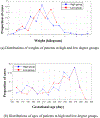Perioperative Care Structures and Non-Routine Events: Network Analysis
- PMID: 35673035
- PMCID: PMC9213069
- DOI: 10.3233/SHTI220096
Perioperative Care Structures and Non-Routine Events: Network Analysis
Abstract
Non-routine events (NREs) are any aspect of care perceived by clinicians as a deviation from optimal care. The reporting of NREs to peers (or care teams) may help healthcare organizations improve patient safety in high-risk work environments (e.g., surgery). While various factors, including care structure and organizational factors may influence a clinician's NRE reporting behavior, their role has not been systematically studied. We conducted a retrospective study relying on NREs and electronic health records to determine if perioperative interaction structures among clinicians are associated with the frequency of NRE reporting in a large academic medical center. The data covers November 1, 2016, to January 31, 2019 and includes 295 perioperative clinicians, 225 neonatal surgical cases, and 543 NREs. Using network analysis, we measured a clinician's status in interaction structures according to the sociometric factors of degree, betweenness, and eigenvector centrality. We applied a proportional odds model to measure the relationship between each sociometric factor and NRE reporting frequency. Our findings indicate that the centrality of clinicians is directly associated with the quantity of NREs per surgical case.
Keywords: Network analysis; neonatal intensive care unit; perioperative interaction structure.
Figures






References
-
- Weinger MB, Slagle J. Human factors research in anesthesia patient safety: Techniques to elucidate factors affecting clinical task performance and decision making. JAMIA. 2002;9(6 (supplement)):S58–S63.
-
- Weinger MB, Slagle J, Jain S, Ordonez N. Retrospective data collection and analytical techniques for patient safety studies. J Biomed Informatics. 2003;36:106–119. - PubMed
-
- Oken A, Rasmussen MD, Slagle JM, et al. A facilitated survey instrument captures significantly more anesthesia events than does traditional voluntary event reporting. Anesthesiology. 2007;107(6):909–922. - PubMed
MeSH terms
Grants and funding
LinkOut - more resources
Full Text Sources
Medical

